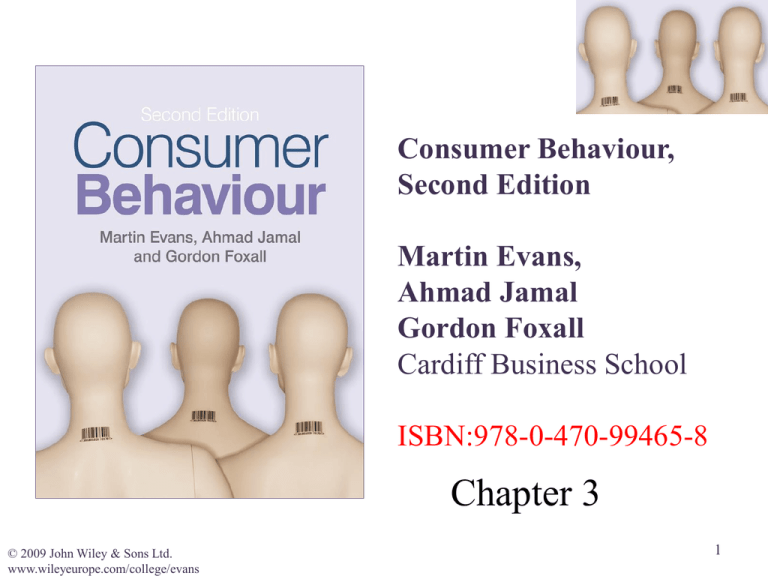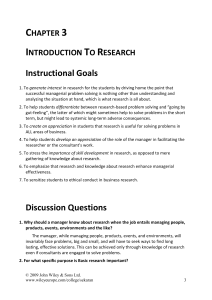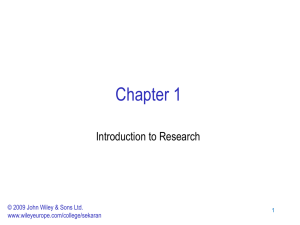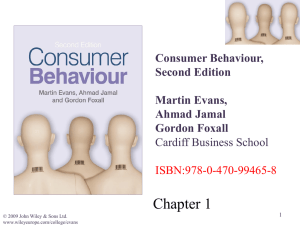Classical Conditioning
advertisement

Consumer Behaviour, Second Edition Martin Evans, Ahmad Jamal Gordon Foxall Cardiff Business School ISBN:978-0-470-99465-8 Chapter 3 © 2009 John Wiley & Sons Ltd. www.wileyeurope.com/college/evans 1 Chapter 3 Consumer Responses to Marketing Actions: 2 Learning and Attitudes © 2009 John Wiley & Sons Ltd. www.wileyeurope.com/college/evans 2 Chapter Objectives • Integrate concepts from psychology within a consumer model • Apply aspects of behavioural learning to increase marketing effectiveness • Apply aspects of cognitive learning to increase marketing effectiveness • Analyse and evaluate different approaches to explaining the link between attitudes and behaviour • Explain different approaches to attitude formation and change © 2009 John Wiley & Sons Ltd. www.wileyeurope.com/college/evans 3 Sequential Model of Response to Marketing Post-purchase Action Attitude Learning Perception Attention Exposure © 2009 John Wiley & Sons Ltd. www.wileyeurope.com/college/evans 4 Learning • One aim of marketing communications is to create awareness (teach consumers) about market offerings • Hence, marketers can benefits from knowing about how consumers learn about things • Learning is closely associated with perception – both are shaped by a person’s motives © 2009 John Wiley & Sons Ltd. www.wileyeurope.com/college/evans 5 Learning & Memory Learning and memory are interrelated yet different concepts. Learning deals with how we acquire new information whereas memory is the internal recording of information or experiences and is related to our ability to store, retain, and subsequently recall information. Forgetting is our inability to retrieve previously stored information. This could be caused by many factors including the probability that the information was never encoded into long term memory in the first place (encoding failure) or that, for some reason, we are unable to retrieve the information from long term memory (retrieval failure). © 2009 John Wiley & Sons Ltd. www.wileyeurope.com/college/evans 6 Two Main Approaches to Learning Behavioural Learning Classical (or Associationist) Conditioning Operant (or instrumental) conditioning Cognitive Learning Kohler’s experiments Gestalt Psychology Vicarious Learning Measurement of Learning © 2009 John Wiley & Sons Ltd. www.wileyeurope.com/college/evans 7 Classical Conditioning • Originally based on Russian physiologist Ivan Pavlov (1928) who conducted some experiments to observe dogs’ responses to different stimuli • His observation: dogs salivated not only when presented food, but also when they heard the footsteps of assistants • Presented various other stimuli at the same time as presenting food • Dogs salivated even when no food was served • The notion of pairing stimuli simultaneously became popular and is widely known as classical conditioning © 2009 John Wiley & Sons Ltd. www.wileyeurope.com/college/evans 8 Pavlovian Classical Conditioning Unconditioned Stimulus Meat paste Unconditioned Response Salivation Neutral Stimulus Bell AFTER REPEATED PAIRINGS Conditioned Stimulus Bell Conditioned Response Salivation Example Unconditioned Stimulus Dinner aroma Unconditioned Response Salivation Neutral Stimulus 6 O’clock news AFTER REPEATED PAIRINGS Conditioned Stimulus 6 O’clock news Conditioned Response Salivation Classical Conditioning: Marketing Applications • Principles of classical conditioning are widely used • A brand can be simultaneously and repetitively paired with, say popular music, so that each time the consumer thinks of the brand the positive feelings associated with that music are aroused • Other examples include the use of celebrities in advertising and the aim is to transfer the endorser’s characteristics and what they stand for to the brand © 2009 John Wiley & Sons Ltd. www.wileyeurope.com/college/evans 11 Classical Conditioning: Marketing Applications Classical Conditioning Food Safety Salivate Volvo=safety Bell Volvo Association © 2009 John Wiley & Sons Ltd. www.wileyeurope.com/college/evans 12 Example: Marlboro Unconditioned Stimulus Marlboro Unconditioned Response Smoking Neutral Stimulus Cowboy AFTER REPEATED PAIRINGS Conditioned Stimulus Cowboy Conditioned Response Smoking Classical Conditioning: Marketing Applications Brand associations made by a group of students: • Volvo = safety • Gold Gti = sporty • BMV = quality • Levi = trendy youth Try this for yourself. Get a friend to list some well-known brands and then to ask you to spontaneously come up with what they mean to you. • Wrangler = cowboys • Benetton = colourful © 2009 John Wiley & Sons Ltd. www.wileyeurope.com/college/evans 14 Classical Conditioning: Marketing Applications Creating an association between health and looks and buying a mattress from Ikea! © 2009 John Wiley & Sons Ltd. www.wileyeurope.com/college/evans 15 Operant Conditioning • This approach to understanding learning is based on the work of Skinner (1938) • Frequency of occurrence of a specific behaviour is modified by the consequences of that behaviour • Learning can be encouraged through the use of positive and negative reinforcements • By pairing rewards or punishments with certain behaviour, Skinner showed that these behaviours can be reinforced © 2009 John Wiley & Sons Ltd. www.wileyeurope.com/college/evans 16 Operant Conditioning: Marketing Applications • Principles of operant conditioning are also widely used • A supermarket offers a price reduction of 10% off everything bought at the time of purchase to increase the possibility that consumers will repeat behaviour (shop at store) • Loyalty Card Benefits • A charity sends direct mail to consumers with a free pen; the consumer keeps the pen even though they do not donate (they are positively rewarded for opening the mail); next time around they look for direct mailing from the charity still with no intention of donating, but looking for a gift © 2009 John Wiley & Sons Ltd. www.wileyeurope.com/college/evans 17 Cognitive Learning • The cognitive perspective on learning rejects the behavioural approach to learning and hence argues that learning involves more than stimulus-response processes • As part of the learning process, consumers can develop mental associations which may not always be reflected in overt behavioural changes • The focus is on what happens in the consumer’s mind (the black box) and the cognitive processes of evaluation and interpreting information • New knowledge is learned and integrated with existing knowledge © 2009 John Wiley & Sons Ltd. www.wileyeurope.com/college/evans 18 Cognitive Learning • E.g. Gestalt Theory (not a person) • Kohler’s experiments • Vicarious learning © 2009 John Wiley & Sons Ltd. www.wileyeurope.com/college/evans 19 Puzzle: Welsh Gestalt Law of Closure Just a little bit of extra mental processing can lead to more effective learningbecause we have to engage/participate more so. It’s a example of learning by doing © 2009 John Wiley & Sons Ltd. www.wileyeurope.com/college/evans Photograph: Martin Evans 20 Reproduced by permission of Proximity London and Volkswagen Group UK Ltd © 2009 John Wiley & Sons Ltd. www.wileyeurope.com/college/evans 21 Vicarious Learning Britney Spears is a Grammywinning American pop singer, dancer, actress, songwriter, and endorsement model. She is also ranked as the 8th best-selling female recording artist in the United States. Despite many personal problems, she is still very popular among teenage girls. This Hidden Fantasy ad extends her personality to the perfume brand. PRNewsFoto/Elizabeth Arden © 2009 John Wiley & Sons Ltd. www.wileyeurope.com/college/evans 22 Measurement of Learning • The degree of brand awareness, brand recognition and/or brand recall aroused in the respondents by the stimulus (advertising) • The recognition method • Aided recall method © 2009 John Wiley & Sons Ltd. www.wileyeurope.com/college/evans 23 Back to the Sequential Method Post-purchase Action Attitude Learning Perception Attention Exposure © 2009 John Wiley & Sons Ltd. www.wileyeurope.com/college/evans 24 Attitudes • A predisposition to respond in a consistent or predictable manner to the stimulus • Attitudes can be towards: • Physical object (e.g. a brand or product) • Social object (e.g. a sales assistant) • An action (e.g. buying products that can harm the environment) • Advertising (e.g. a particular ad) © 2009 John Wiley & Sons Ltd. www.wileyeurope.com/college/evans 25 Structural Approaches to Attitudes • Cognitive component A person’s beliefs or knowledge about an issue or object • Affective component A person’s feelings or emotions about the issue of the object; these feelings can be ‘positive’ or ‘negative’ • Behavioural component Consists of how the individual is likely to respond to the object based on what they know and feel about it © 2009 John Wiley & Sons Ltd. www.wileyeurope.com/college/evans 26 We seek equilibrium in attitude formation … • Alex wants to date Larry; Alex has positive sentiment toward Larry • Larry wears earring; Larry has positive attitude toward earring • Alex doesn’t like men who wear earrings; has negative sentiment toward earrings Attitude measurement For the (1) direct mail (2) Telesales you receive, in general do you think it is: Interesting 1 2 3 4 5 Uninteresting Informative 1 2 3 4 5 Uninformative Intrusive 1 2 3 4 5 Not Intrusive Entertaining 1 2 3 4 5 Not Entertaining 1 2 3 4 5 1 2 3 4 5 Damages the Environment Relevant to You 1 © 2009 John Wiley & Sons Ltd. www.wileyeurope.com/college/evans Doesn’t Damage Environment Not Relevant to You 2 Semantic Differential 28 Attitude measurement Strongly Agree Strongly Disagree I like organs sending me product or service information 1 2 3 4 5 I like to decide for myself where to look for product information 1 2 3 4 5 1 2 3 4 5 1 2 3 4 5 Stronger laws needed to control sharing of personal information 1 2 3 4 5 Marketers have generally got my details correct 1 2 3 4 5 I like to deal with organisations over the phone 1 2 3 4 5 I like to deal with organisations through the post 1 2 3 4 5 The more organs know about me, the better they can meet my needs I really don’t mind marketers having my personal details © 2009 John Wiley & Sons Ltd. www.wileyeurope.com/college/evans Likert Scales 29 Attitude Change • How? • Advertising can be an important tool for attitude formation and change • Usage Rational and Emotional cues © 2009 John Wiley & Sons Ltd. www.wileyeurope.com/college/evans 30 Rational Message Appeal © 2009 John Wiley & Sons Ltd. www.wileyeurope.com/college/evans 31 Emotional Message Appeal © 2009 John Wiley & Sons Ltd. www.wileyeurope.com/college/evans 32 Fear Appeal A fear appeal is presented in this ad to encourage parents to talk frankly with their children about various issues including drugs, drinking, tobacco, and sex. This ad is effective because it addresses a fear that every parent has, and suggests courses of actions that parents can take to decrease that fear. Courtesy National Youth Anti-Drug Media Campaign © 2009 John Wiley & Sons Ltd. www.wileyeurope.com/college/evans 33




